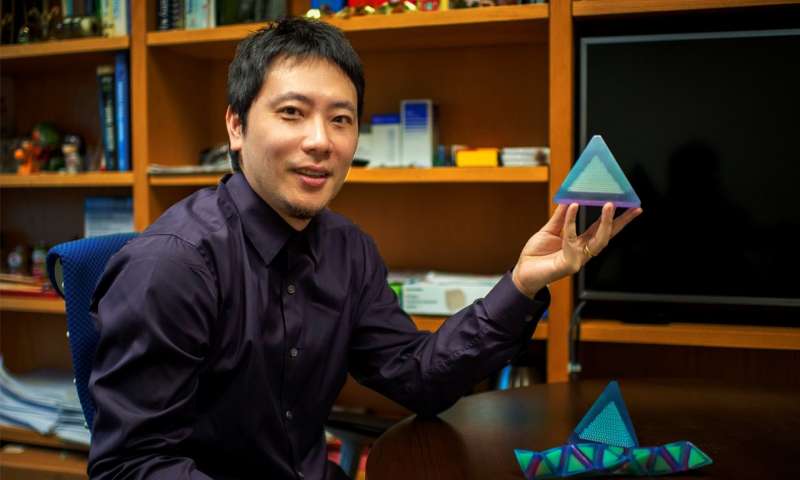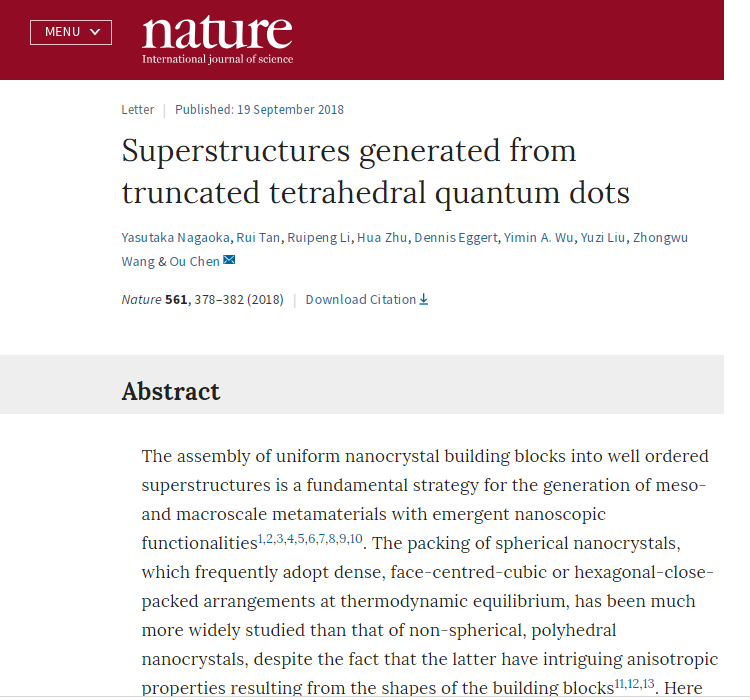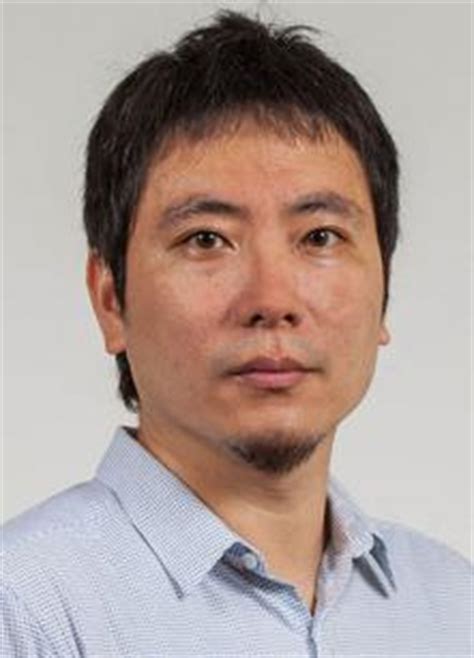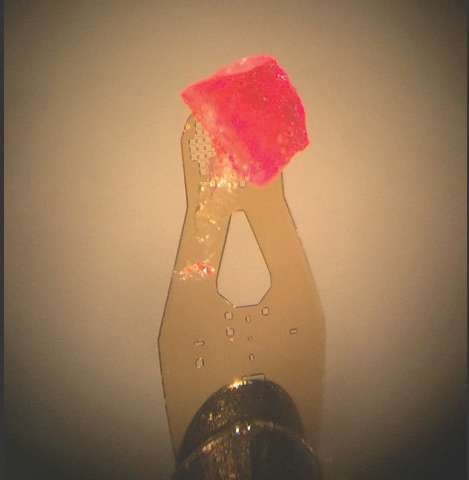点击:中国科大硅谷创新家晚宴报名入口
2018年9月20日北京时间凌晨1点,993校友陈鸥博士等以重磅Nature论文向中国科大六十周年校庆献礼!
陈鸥教授的论文题为《Superstructures generated from truncated tetrahedral quantum dots》,值得说明的该文章除通讯作者陈鸥,其余8位作者中还有2位谭锐博士(02206)与李锐鹏博士(9914)也都是中国科大校友。前述三位均为中国科大化学材料学院毕业生。
陈鸥早在8月中已告知新创基金会他的自然成果被接收。但直到新创基金会致电他并不知论文已在自然杂志官网上线。他高兴的表示“果真是和潘老师的一起呀,太巧了!给科大献礼啦”。陈鸥博士对中国科大的教育深怀感激。2018年8月,他曾表示非常感谢北京招生组把他带到科大;真的只有科大让他考虑去读博,走上化学家之路。
陈鸥听说潘之队在9月20日凌晨以顶级科学期刊《自然》为母校祝寿时表示:见贤思齐!向潘教授学习!俺也来一篇呗!(注:这句话别当真哈)
北京时间9月20日,布朗大学官网以《用金字塔形纳米量子点搭出世界最复杂超晶格结构》报道了陈鸥教授的成果,其英文新闻附后。
陈鸥博士简介
陈鸥1999年从北京101中学考入中国科大化学物理系学习;2010年获得佛罗里达大学博士学位;其后曾为麻省理工学院博士后研究员,现为布朗大学助理教授。
New nanoparticle superstructures made from pyramid-shaped building blocks
In research that may help bridge the divide between the nano and the macro, Brown University chemists have used pyramid-shaped nanoparticles to create what might be the most complex macroscale superstructure ever assembled. Brown chemist Ou Chen holds a mock-up of one of his quantum dot building blocks. Credit: Brown University
Researchers from Brown University have assembled complex macroscale superstructures from pyramid-shaped nanoparticle building blocks. The research, described in the journal Nature, demonstrates a promising new way to bring the useful properties of nanoparticles to macroscale materials and devices.
"There's been a lot of research in making superstructures from spherical nanoparticles, but much less using tetrahedral building blocks," said Ou Chen, an assistant professor of chemistry at Brown and senior author of the study. "Tetrahedra open the possibility of making much more complex structures, and the 3-D superstructure we demonstrate here is one of the most complex ever assembled from single nanoparticle components."
Chen's research group developed the building blocks used in the study a year ago. The particles are quantum dots—nanoscale semiconductors that can absorb and emit light. Their tetrahedral (pyramid-like) shape has important advantages over spheres, Chen says, when using them to build larger structures. Tetrahedra can pack together with less void space than spheres, making structures potentially more robust. In addition, the particles used in the study are anisotropic, meaning they have different properties depending upon their orientation relative to each other. Spheres, on the other hand, are the same in every direction.
In the case of the tetrahedral quantum dots, anisotropy was generated by treating one flat face, or facet, of each pyramid with a different ligand (a chemical bonding agent) than the other facets.
"Ligands help direct the touching process that occurs when two particles come together facet to facet," said Yasutaka Nagaoka, a postdoctoral researcher in Chen's group and the major contributor to the project. "In this case, facets with like ligands attract, which offers a degree of control over how the particles arrange themselves."
That's in contrast to isotropic spheres, which arrange themselves randomly.
"Anisotropy adds to the complexity of the superstructures we can make compared to using isotropic spheres," Chen said. "It also gives us some power to control the atomic alignment of the particles in the supercrystals, which could give rise to interesting properties. For example, you can predict that alignment will give rise to better electronic properties because electrons hop more easily through the lattice of the superstructure."
For their study, Chen and his colleagues dissolved their tetrahedral quantum dots in solution, then allowed the particles to assemble into three different types of superstructures: one-dimensional strands, two-dimensional crystal lattices and three-dimensional supercrystals.
The 3-D supercrystals were particularly interesting, Chen says, because of their complexity and the interesting way in which they formed. The individual nanoparticles first formed ball-like clusters of 36 particles each. Those clusters then formed the larger superstructures. When the researchers characterized the structure in detail using X-ray scattering, they found that the atomic structure of the lattice was indeed aligned, as they had hoped.
Magnified image of a superstructure built from nanoscale tetrahedral building blocks. The blocks' edges are each about nine nanometers in length. The superstructures built from them are between 200 and 300 micrometers across. Credit: Chen Lab/Brown University
Now that they've shown a method for forming the structures, the next step is to interrogate their properties.
"The quantum dot building blocks are interesting by themselves," Chen said. "They have interesting photon dynamics, which may translate into interesting optical properties in the superstructures.
"We need to understand how to assemble these larger and more complex structures," he said. "I think these will be a bridge that will bring nanoscale dynamics into the macroscale and enable new types of metamaterials and devices."




